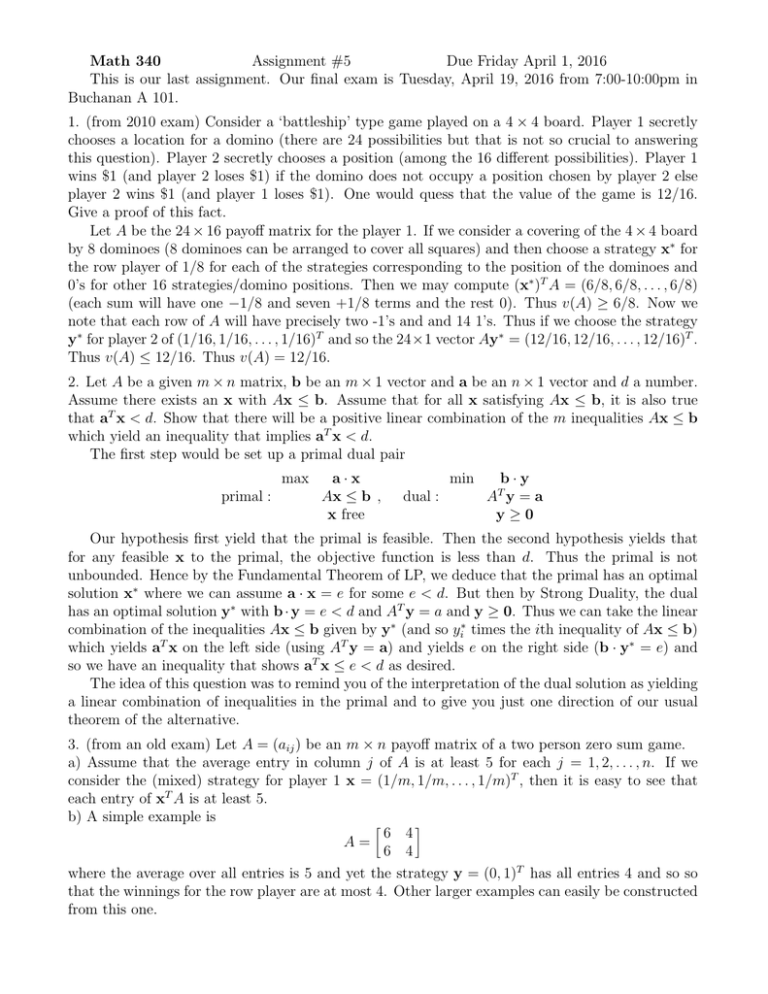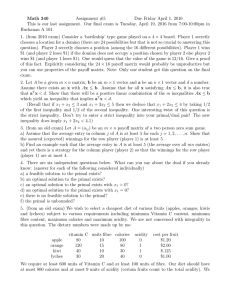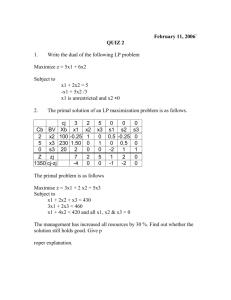Math 340 Assignment #5 Due Friday April 1, 2016
advertisement

Math 340 Assignment #5 Due Friday April 1, 2016 This is our last assignment. Our final exam is Tuesday, April 19, 2016 from 7:00-10:00pm in Buchanan A 101. 1. (from 2010 exam) Consider a ‘battleship’ type game played on a 4 × 4 board. Player 1 secretly chooses a location for a domino (there are 24 possibilities but that is not so crucial to answering this question). Player 2 secretly chooses a position (among the 16 different possibilities). Player 1 wins $1 (and player 2 loses $1) if the domino does not occupy a position chosen by player 2 else player 2 wins $1 (and player 1 loses $1). One would quess that the value of the game is 12/16. Give a proof of this fact. Let A be the 24 × 16 payoff matrix for the player 1. If we consider a covering of the 4 × 4 board by 8 dominoes (8 dominoes can be arranged to cover all squares) and then choose a strategy x∗ for the row player of 1/8 for each of the strategies corresponding to the position of the dominoes and 0’s for other 16 strategies/domino positions. Then we may compute (x∗ )T A = (6/8, 6/8, . . . , 6/8) (each sum will have one −1/8 and seven +1/8 terms and the rest 0). Thus v(A) ≥ 6/8. Now we note that each row of A will have precisely two -1’s and and 14 1’s. Thus if we choose the strategy y∗ for player 2 of (1/16, 1/16, . . . , 1/16)T and so the 24×1 vector Ay∗ = (12/16, 12/16, . . . , 12/16)T . Thus v(A) ≤ 12/16. Thus v(A) = 12/16. 2. Let A be a given m × n matrix, b be an m × 1 vector and a be an n × 1 vector and d a number. Assume there exists an x with Ax ≤ b. Assume that for all x satisfying Ax ≤ b, it is also true that aT x < d. Show that there will be a positive linear combination of the m inequalities Ax ≤ b which yield an inequality that implies aT x < d. The first step would be set up a primal dual pair max primal : a·x Ax ≤ b , x free min dual : b·y AT y = a y≥0 Our hypothesis first yield that the primal is feasible. Then the second hypothesis yields that for any feasible x to the primal, the objective function is less than d. Thus the primal is not unbounded. Hence by the Fundamental Theorem of LP, we deduce that the primal has an optimal solution x∗ where we can assume a · x = e for some e < d. But then by Strong Duality, the dual has an optimal solution y∗ with b · y = e < d and AT y = a and y ≥ 0. Thus we can take the linear combination of the inequalities Ax ≤ b given by y∗ (and so yi∗ times the ith inequality of Ax ≤ b) which yields aT x on the left side (using AT y = a) and yields e on the right side (b · y∗ = e) and so we have an inequality that shows aT x ≤ e < d as desired. The idea of this question was to remind you of the interpretation of the dual solution as yielding a linear combination of inequalities in the primal and to give you just one direction of our usual theorem of the alternative. 3. (from an old exam) Let A = (aij ) be an m × n payoff matrix of a two person zero sum game. a) Assume that the average entry in column j of A is at least 5 for each j = 1, 2, . . . , n. If we consider the (mixed) strategy for player 1 x = (1/m, 1/m, . . . , 1/m)T , then it is easy to see that each entry of xT A is at least 5. b) A simple example is 6 4 A= 6 4 where the average over all entries is 5 and yet the strategy y = (0, 1)T has all entries 4 and so so that the winnings for the row player are at most 4. Other larger examples can easily be constructed from this one. 4. There are six independent questions. What can you say about the dual if you already know (answer for each of the following considered individually) a) a feasible solution to the primal exists? If a feasible solution to the primal exists, the dual cannot be unbounded. b) an optimal solution to the primal exists? If an optimal solution to the primal exists, then by Strong Duality, there is an optimal solution to the dual with the same value of the objective function. c) an optimal solution to the primal exists with x1 > 0? If an optimal solution to the primal exists with x1 > 0, then we have the same conclusion as b), but using the Theorem of Complementary Slackness, we deduce that any optimal solution to the dual has the first constraint being equality (first dual slack is 0). d) an optimal solution to the primal exists with x1 = 0? If an optimal solution to the primal exists with x1 = 0, then we cannot make any grander observations than that of b). In some instances, x1 = 0 may force other facts. e) there is no feasible solution to the primal? If there is no feasible solution to the primal, then by Strong Duality, the dual cannot have an optimal solution. Thus the dual is either unbounded or is infeasible. f) the primal is unbounded? If the primal is unbounded then the dual is infeasible. 5. (from an old exam) We wish to select a cheapest diet of various fruits (apples, oranges, kiwis and lychees) subject to various requirements including minimum Vitamin C content, minimum fibre content, maximum calories and maximum acidity. We are not concerned with integrality in this question. The dietary numbers were made up by me. apple orange kiwi lychee vitamin C units fibre calories 80 10 100 120 15 80 40 10 30 30 20 40 acidity 0 1 1 0 cost per fruit $1.20 $2.00 $.125 $1.00 We require at least 600 units of Vitamin C and at least 100 units of fibre. Our diet should have at most 800 calories and at most 9 units of acidity (certain fruits count to the total acidity). We formulate the problem as a Maximum problem by taking the negative of the cost. Our LINDO input is: max -1.2apple-2orange-.125kiwi-lychee st vitaminc)80apple+120orange+40kiwi+30lychee>600 fibre)10apple+15orange+10kiwi+20lychee>100 calories)100apple+80orange+30kiwi+40lychee<800 acidity)orange+kiwi<9 end The LINDO output is on the next page. Each of the following questions are independent of each other. When giving costs, you can report the cost to the nearest cent. a) [3 marks] How much does the diet cost? How much more would a new optimal diet cost if the minimum requirement of Vitamin C is increased by 100. The current diet costs $4.73. If we increase the Vitamin C requirement to 100 then we see that the marginal value is $.015 and so an increase of 100 would be predicted to cost $1.50 and thus the new diet would cost $6.23. We check the allowable ranges and find that we can increase the righthand side of the vitamin C constraint by 184 so the prediction is accurate. b) [2 marks] If I allowed up to 15 units of acidity, what would a new optimal diet cost? The marginal value for acidity is $.475 (quite large!) and the allowable increase is 6 and so we expect savings of 6×$.475=$2.85 with the final diet costing $1.88 c) [2 marks] If I need to restrict my calorie intake (from fruits) to have at most 600 calories, what would a new optimal diet cost? This would have the same cost; the slack in the calorie constraint was 230 (i.e. total calories of optimal diet is 800-230=570) which is greater than the desired decrease. d) [3 marks] If I raise the minimum Vitamin C requirement from 600 to 690 and lower the maximum acidity from 9 to 7, what would a new optimal diet cost? Note that we are proposing two changes that are at most half of the ‘allowable’ changes. Explain why the marginal values are still useful. This is equivalent to the following idea. Let b1 have +180 in the calorie row with 0’s elsewhere and let b2 have -4 in the acidity row with 0’s elsewhere. We are given that B −1 (b + b1 ) ≥ 0 and B −1 (b + b2 ) ≥ 0 from which we may conclude B −1 (b + 1/2b1 + 1/2b2 ) = B −1 (1/2b + 1/2b1 ) + B −1 (1/2b + 1/2b2 ) ≥ 0 e) [3 marks] Consider adding a new fruit to the diet. A single rambutan costs $.50 and has 50 units of Vitamin C, has 10 units of fibre, has 25 calories and has half the acidity of an orange or kiwi. Would a new optimal diet would contain this fruit? Rambutans are occasionally available in Vancouver. The marginal cost of the rambutan would be 50 × −.015 + 10 × 0 + 25 × 0 + 1/2 × .475 = −.515 or the marginal value would be 50 × .015 + 10 × 0+25×0+1/2×−.475 = .515 > .50 so the new optimal diet would contain this fruit. The difficulty here is the sign of the marginal values but it should be clear that the vitamin C contribution is positive while the acidity contribution is negative. Part d) partially answers whether the marginal values are valid for a purchase of a non zero quantity of rambutans.








